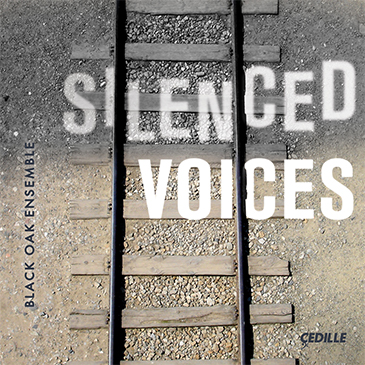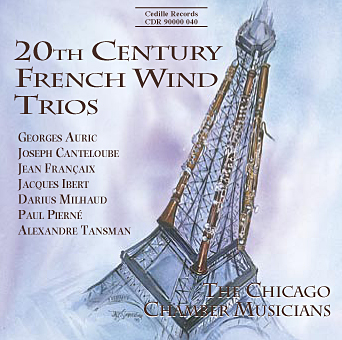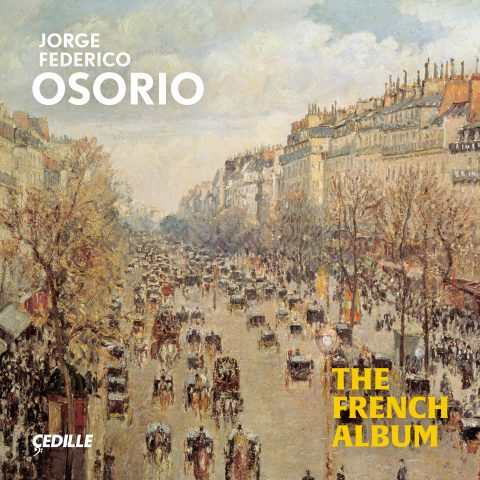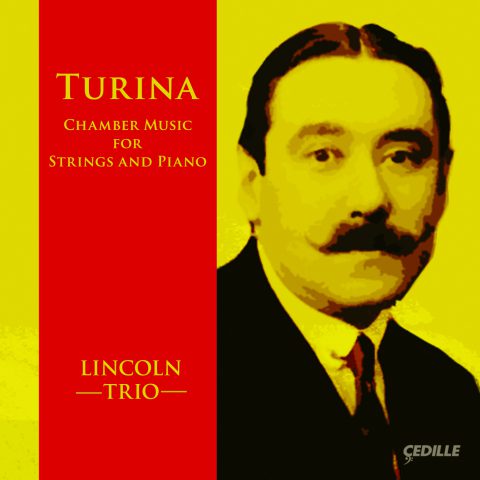| Subtotal | $36.00 |
|---|---|
| Tax | $3.70 |
| Total | $39.70 |
Store
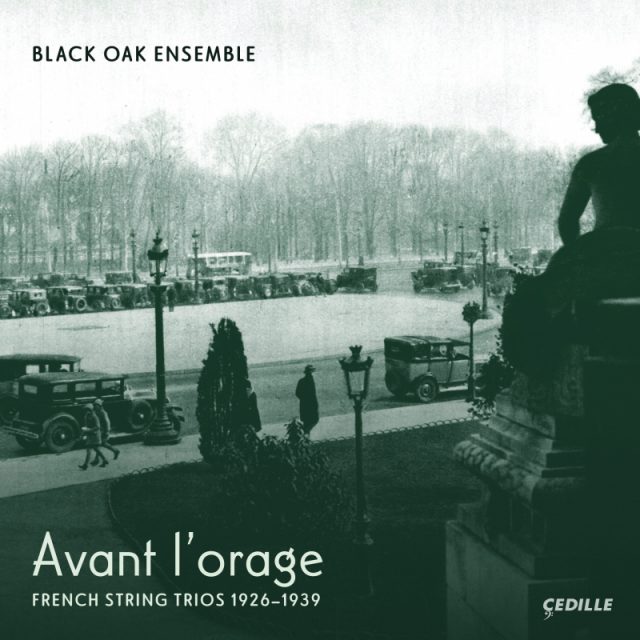
Store
Avant l’orage: French String Trios 1926–1939
Black Oak Ensemble, the Chicago-based string trio with an international following, treats listeners to a double-album of stylish and often witty French treasures written between the World Wars.
The ensemble offers seven rarely heard delicacies from the 1920s and 30s, including world premiere recordings of trios by Henri Tomasi, Robert Casadesus, and Gustave Samazeuilh along with works by Jean Cras, Emile Goué, Jean Françaix, and Gabriel Pierné. Most were written for and dedicated to the virtuosic Trio Pasquier, which ranked among the era’s chamber music superstars.
Tomasi’s Mediterranean roots are heard in the Provençal folk melody referenced in his Trio à cordes en forme de divertissement, noted for its colorful, kaleidoscopic finale. Casadesus’s Trio à cordes combines fine craftsmanship and poetic sincerity. Samazeuilh, a disciple of Claude Debussy, wrote his Suite en trio in the form of a Baroque dance suite.
Celtic-infused folk music of his native Brittany emerges in Cras’s Trio pour violon, alto et violoncelle, as does an homage to Beethoven’s Op. 132 string quartet. Goué wrote his Trio pour violon, alto et violoncelle, energized with folk-dance elements, on the eve of his World War II army deployment. Françaix’s Trio displays his trademark textural clarity, agility, and sense of humor. Pierné’s Trois pièces en trio has even more fun with the listener with its satirical finale conjuring intoxicated, stumbling “fat cats” (actually an ironic reference to clerics/priests) out on the town.
Preview Excerpts
HENRI TOMASI (1901–1971)
Trio à cordes en forme de divertissement
JEAN CRAS (1879–1932)
Trio pour violon, alto et violoncelle
ÉMILE GOUÉ (1904–1946)
Trio pour violon, alto et violoncelle
JEAN FRANÇAIX (1912–1997)
Trio
Artists
Program Notes
Download Album BookletAvant l'orage
Notes by Elinor Olin
A String Trio is both a genre of music and a type of performing ensemble; both are rare and difficult to find in their most exquisite forms. In French, the instruments are violon, alto (viola) and violoncelle. Although many composers have (perhaps mistakenly) passed over the string trio in favor of other, more common types of chamber music, they can be true gems when performed by soloists of the highest order. In the ensemble, the balance of sound and pitch must be impeccable; for each player, there is nowhere to hide. The Black Oak Ensemble — three soloists interacting as this superlative ensemble — have made it their mission to seek out unknown string trios. Three works receive their world premiere recordings on this disc.
Each of the composers represented has a unique musical voice and temperament, and all resisted the “-isms” of the early 20th century in the Interwar years — either as outsiders (especially Cras, Goué, and Tomasi) or through stubborn independence. Why did these composers choose to write string trios? The chronology of these works’ composition, in view of yet another approaching world war, may have influenced the choice of a genre easily realized by only three, easily portable instruments. One thread connecting these works and the time period of their creation is the Trio Pasquier: three brothers (Jean, violin; Pierre, viola; Étienne, cello) for whom Casadesus, Françaix, Pierné, Samazeuilh, and Tomasi wrote and dedicated their string trios. The Pasquier brothers were the best game in Europe and continued to perform these works in radio broadcasts, even during the war years. The Black Oak Ensemble continues their legacy, bringing these gems to 21st century listeners.
HENRI TOMASI (1901–1971)
Trio à cordes en forme de divertissement (1938) “Pour les frères Pasquier”
Henri Tomasi was born in Marseilles on August 17, 1901 to Corsican parents. His father, an amateur flutist who published several collections of Corsican folksongs, encouraged his son to study music — and forbade him from pursuing his first interest, a life at sea. The gifted young Tomasi won top prizes in music theory, piano, and harmony at the Marseilles Conservatory and then, with the financial assistance of a benefactor, moved to Paris to attend the Conservatoire National Supérieur de Musique. His studies delayed by WWI, he was forced to earn a living playing piano in the cabarets of the Pigalle district and in silent film houses, where he learned to improvise and to respond musically to the variety of emotions shown on screen. In 1927, he earned top honors at the Paris Conservatoire in composition and conducting. Directly afterward, he began a renowned career as a conductor, first with the orchestra of the Concerts du Journal and then, in 1931, for Radio-Colonial, one of France’s first radio stations. A founding member of the Triton Society, Tomasi was active — from 1932 along with Jean Francaix, Gabriel Pierné, Francis Poulenc, the Trio Pasquier, and others — in this group dedicated to promoting and encouraging contemporary music.
Tomasi’s international success as a conductor surpassed his fame as a composer especially in France. Best known today for his virtuosic trumpet and trombone concertos, his impressive compositional output of nearly 120 opus numbers ranges from the large-scale (operas, ballets, concertos, and symphonic works) to the more intimate, including chamber music for a remarkable variety of instrumental groups. Tomasi’s Mediterranean roots are reflected in numerous compositions, from the early Variations sur un thème corse (1925) for wind quintet to his Trois pastorales provençales for two guitars and string orchestra (1966). His stagework, Les santons (Provençal for “little saints”) came in the same year as the Trio à cordes, and both pieces share melodic references to a folk song from the region.
The Trio’s opening Prélude features staidly conservative harmonic language, and traditional roles for violin with accompanimental viola and cello are reinforced by a four-note rhythmic figure that may be a reference to Beethoven. The implication of the title divertissement comes more into focus in the second movement, Nocturne, where the listener is brought gently into a more recent musical idiom as layered themes of cello and viola circle around the dissonant interval of the tritone cradled in swaying, barcarolle rhythms. The delayed entry of the violin in a different meter (4/4 against the other instruments’ 12/8) is almost jarring in its straightforward presentation of melody, while the instruments’ intricate textural combinations are masterfully French.
The virtuosic Scherzo’s energetic opening melody is quickly and seamlessly handed off from one instrument to the next, creating the impression of a single, wide-ranging line. The movement’s unmarked “Trio” section slows in pace and quotes the preceding Nocturne before returning to the energetic character of the Scherzo.
The “Final” evokes a celebratory folk dance, with an open-fifth accompaniment in the viola and cello underscoring a sprightly melody in the violin. This melody is very similar to the Provençal air, “Les Olivettes,” quoted in other Tomasi works, including Les Santons mentioned above. The sectional format of the tightly constructed Final reflects another recurring Tomasi characteristic: constantly changing, sometimes highly contrasting colors of an aural kaleidoscope.
Musicologist Fredéric Ducros remarked that Tomasi’s music has been relegated to “an unjust neglect, waiting to be discovered by today’s musicians.” Black Oak Ensemble’s world premiere recording is a significant step toward that deserved wider recognition.
JEAN CRAS (1879–1932)
Trio pour violon, alto et violoncelle (1926)
Like his younger contemporary Tomasi, the Breton Jean Cras was drawn to the sea but, unlike Tomasi, chose a career in the French navy. The son of a Navy doctor, Cras led a double life. His public persona was that of a naval officer and scientist who eventually achieved the rank of Rear Admiral and is credited with the invention of the règle-rapporteur Cras, a navigational ruler-compass that became standard issue for all French armed forces after 1917. His more private avocation as a composer was largely achieved while at sea — sometimes in perilous, war-time circumstances.
In preparation for his naval career, Cras received advanced training in science and architecture. As a composer, Cras was essentially an autodidact. His musical training, initially from his mother, in whose celebrated salons Cras performed Beethoven piano sonatas and either violin or viola in his string quartets, did not include conservatory studies. Private study with composer Henri Duparc during a three-month hiatus in his military career provided his only real training in harmony, counterpoint, and musical form.
Cras’ compositional output includes stage, orchestral and choral works. His preferred medium of expression however, was chamber music. This can be seen particularly in his mature works, all but two of which (written between 1922 and 1929) are scored for chamber ensembles.
Cras penned his Trio pour violon, alto et violoncelle between March and June 1926 while stationed at Lorient, an important naval port on the Brittany coast. The first movement has no tempo marking or title, perhaps reflecting the composer’s no-nonsense, scientific outlook. Swaying, syncopated figuration in the violin and viola is set against squarely repeated notes in the cello.
Gradually taken up by all three instruments, these undulating figures develop into thematic material that forms the basis of the movement. An angular double-dotted motive is introduced as contrast to soaring violin melodies before the initial theme returns, first in a tempo that is doubled in pace and marked martelé (literally “hammered,” a bow stroke with a percussive sforzando attack and a silence between notes). The opening thematic material returns to close the movement calmly, gradually slowing to a sustained chord.
The structure of the second movement is an homage to the slow movement of Beethoven’s Op. 132 string quartet, the miniature score of which Cras always kept at his side while on naval duty. Infused into the Classical references are many elements of Breton folk music, including frequent allusions to the biniou, a Breton bagpipe. The viola/cello open-fifth accompaniment early in the movement provides an authentic sonic foundation to the modally inflected violin line. A violin cadenza further evokes Breton folk music with the “fifing” style of the bombarde (an oboe-like instrument) before the meter shifts to 7/4, echoing the metric irregularity of melodic phrasing in Celtic folk songs. The movement closes with the layering of canonic imitation between the viola and cello coincidental with a bombarde-inspired violin melody, spiced with harmonics and colorful figurations.
The light-hearted third movement, marked Animé with a strict tempo of 138 beats per minute but “not any faster,” features each instrument as a soloist, often against a steady, open-fifth accompaniment in the other parts. These solo lines include multi-linear, virtuosic passages simulating the bombarde + biniou pairing — played by a single stringed instrument.
The final movement is the most illustrative of the composer’s remark that “the general mood of the work is Breton (like its author).” It’s a Celtic jig based on the dance Tro de Cournouoaille, introduced by the cello with layered entrances by viola and violin. The triplet jig rhythms are transformed to a rippling undercurrent for the violin’s relatively slow-paced, modal melody. The movement ends with the initial dance melody, developed and expanded in range to feature each of the instruments’ technical and expressive capabilities.
ÉMILE GOUÉ (1904 –1946)
Trio pour violon, alto et violoncelle (1939)
When he is mentioned at all in biographical sources, Émile Goué is noted for having given his life for his country. (A recent work is titled Compositeur mort pour la France.) Trained as a mathematician and physicist, Goué was also passionate about music; his thesis was “An Experimental Study of the Sound Qualities of the Tambour Drum.” After being licensed to teach in the sciences, Goué enrolled as a student to study contrabass at the Conservatoire de Toulouse. To help defray tuition expenses, he accompanied silent films at the piano, improvising and translating the visual images into music. This unconventional training was supplemented by private study in harmony and counterpoint with composer Charles Koechlin. Goué was mobilized as a lieutenant in the French Army in 1939 and was captured as a prisoner of war in 1940. During the five years he was held at Stalag Oflag XB, Goué managed to teach music, physics, and chemistry; to form and direct an orchestra; and to compose the majority of his extant works. Shortly after returning to Paris, Goué succumbed to a pulmonary infection brought on by his experience as a prisoner of war.
Written just before the composer’s military deployment, Goué’s string trio begins in a Presto tempo with a unison presentation of its main theme. Frequently changing meters combined with harmonic language that is not quite tonal, hinting at a pentatonic idiom, give this movement a sense of unpredictable forward motion. The Adagio second movement, with its gently rocking theme in the violin (and later the viola) is like a lullaby, with accompaniment derived from the previous movement. The Adagio’s harmonic language is substantially chromatic, with surprise sectional cadences on straightforward major chords.
The final movement features a sprightly, bouncing theme, introduced by the cello. Inspired by folk dance, it offers the triplet profile and energy of a tarantella. A lyrical slow section provides temporary respite before the energetic dance theme returns in fragmented and overlapping contrapuntal entrances. The movement, and indeed the whole work, is summed up with the cello getting the last word.
Goué’s String Trio holds a special place in the composer’s oeuvre as he was fortunate to hear the work premiered in Paris, alongside his mentor Charles Koechlin, in March 1946, just six months before his untimely death.
JEAN FRANÇAIX (1912 –1997)
Trio (1933) “A Messieurs Etienne, Pierre et Jean Pasquier”
Jean Françaix was the son of musical parents who closely supervised his early education. His mother was a singing teacher and founder of a celebrated choir; his father, a composer, pianist, musicologist, and Director of the LeMans Conservatoire. Jean’s musical aptitude was recognized early. Maurice Ravel wrote to the elder Françaix, “among the child’s gifts I observe above all the most fruitful an artist can possess, that of curiosity: you must not stifle these precious gifts now or ever, or risk letting this young sensibility wither.” At age four, the young Françaix was improvising at the piano; at ten, he was accepted as a student of harmony by the famed pedagogue Nadia Boulanger, who later performed or conducted numerous premieres of his works. Continuing his education at the Paris Conservatoire, Françaix received top honors in both composition and piano performance. At 20, he performed his Concertino for piano and orchestra with the prestigious Concerts Lamoureux. He toured extensively as a soloist performing his own music, and with numerous other instrumentalists, including Étienne, Pierre, and Jean Pasquier, the dedicatees of his 1933 string trio.
Françaix’s compositional output encompasses works in a wide range of genres: five operas, a monumental oratorio, orchestral music (including celebrated solo concertos for wind instruments), film music, and 16 ballets. Chamber music seems to have been a preferred medium: a variety of works for combinations of 2–12 instruments, in addition to his compositions for solo piano, form a substantial part of his oeuvre.
Often labelled a neoclassical composer, a descriptor that hardly encompasses the range and breadth of his expression, Françaix wrote this string trio using traditional structures, with notable textural clarity, agility, and characteristic humor. With three out of four movements curiously marked “Vivo,” Françaix leaves it up to the performers to choose just how lively their performance should be. The first movement, Allegretto vivo, is a moto perpetuo with constant 16th notes outlining close melodic intervals in repeated scale fragments. These bits of melodic scales are occasionally expanded rhythmically to grant different soloists the spotlight. Overall, the movement is energetic but restrained, with predominating dynamic levels of pianissimo (pp) and pianississimo (ppp).
The second movement is a playful Scherzo in the traditional tripartite format with a contrasting middle section and a return to the “A” section. Dance-like rhythms are performed with quickly alternating pizzicato (plucked) and arco (bowed) directives. Across-the-bar syncopations add complexity to the fast-moving exchanges of thematic material from instrument to instrument. The unlabeled Trio section is marked “Ironico” and introduces a rustic element with intentional hesitations and syncopation to contrast the sophistication of the previous section. The movement as a whole plays on the listener’s expectations of stable dance rhythms and calls for a highly skilled ensemble performance.
The Andante movement features a solo cantabile melody against sustained, slowly shifting chords in the other instruments. Shifting meters (alternating 4/4 and 3/4) give the music a poetic phrasing, as though unheard lyrics are shaping the syntax of the melody. The final Rondo, once again marked “Vivo,” is the most virtuosic of the Trio —
a tribute to the performance skills of its dedicatees, the Pasquier Trio. The Rondo combines both dance elements of the Scherzo movement: agile playfulness and a more heavy-footed sarcasm. There is a Haydnesque humor to the occasional empty pauses, off-the-beat pizzicato syncopations, and sliding chords marked perdendosi (dying away). The final bars leave us with an impish last word, a ppp ensemble pizzicato chord.
ROBERT CASADESUS (1899 –1972)
Trio à cordes (1938) “Au Trio Pasquier”
The scion of a multi-generational musical family of Catalonian descent, Robert Casadesus is best remembered as a leading concert pianist and pedagogue, less so as a composer. His uncles were conductor/composer Francis Casadesus, cellist Marcel Casadesus, and violinist Marius Casadesus. His father, the only non-musician in his generation, was a well-known actor and theater director known by the stage name Robert Casa. Initially encouraged to take up violin, three-year-old Robert adamantly chose the piano. At age ten he entered the Paris Conservatoire and studied with a pupil of Franz Liszt. World War I interrupted his training; his father’s call up to duty forced the young pianist to seek employment as an extra percussionist in the orchestra of the Théâtre de l’Opéra Comique. After establishing a stellar career as a virtuoso pianist, Casadesus became professor of piano at the American Conservatory at Fontainebleau. After World War II, he made Princeton his home base.
Casadesus notably made duo piano rolls and toured with his close friend Maurice Ravel. His recording of Ravel’s complete piano works continues to be revered, as do his albums of Mozart’s piano concertos with George Szell and Beethoven’s sonatas for violin and piano with Zino Francescatti (a close friend of Tomasi).
Many of Casadesus’ compositions, including four symphonies and five piano concertos, remain in manuscript. His published output is largely for piano, ranging from solo and duo piano works to sonatas for piano and flute, violin, and cello, respectively. His 1938 Trio à cordes, Op. 25, the one published work among Casadesus’ catalog of string chamber music (comprising numerous trios, quartets, and quintets), was never recorded until now.
Casadesus’ compositions are relatively few. According to his daughter, Thérèse Rawson, he wrote mostly while on trains, in between performances. The first movement of the Trio à cordes, Allegro con brio, features interlocking rhythmic patterns in contrasting metrical combinations. The constant motion of these rhythmic patterns could suggest the experience of train travel. Sometimes overlapping, sometimes simultaneous, each of the three instruments participates equally within an elegant, finely crafted contrapuntal texture.
In the second movement, Légende, the slow tempo, a slightly unsettling 5/4 meter, and muted strings combine to evoke an atmosphere shrouded in mist. The gently lyrical character of this opening section with its grace-noted, slow melodies is juxtaposed with an energetic Vivo scherzando middle section featuring a bouncy arabesque figure and across-the-bar rhythms written in a modal syntax. A slow monologue in the viola transitions back to a repeat of the opening section. The movement ends with a short, unison snippet of the Vivo scherzando.
The unusual tempo marking Allegro aperto (Open Allegro) seems a clue to the unconstrained nature of the trio’s final movement. The most dissonant of the three, it begins with a sweeping, dramatic melody in the violin, accompanied by tremolo-like excitement in the viola and cello. The violin’s melody supplies much of the thematic material for the movement which, in keeping with the theatrical charisma of its opening, presents contrasting moods in sections marked “Murmurando” (murmuring), “Deciso” (decisive), and “Appassionato” (passionate). The movement closes with a ff restatement of its dramatic opening theme.
Casadesus’ String Trio is the expression of a unique compositional voice, combining fine craftsmanship and a poetic sincerity not beholden to any “school” or partisan aesthetic movement.
GUSTAVE SAMAZEUILH (1877–1967)
Suite en trio pour violon, alto et violoncelle (1937) “Au Trio Pasquier”
Gustave Samazeuilh was highly regarded as a writer — of music criticism as well as music compositions. He was a disciple of several iconic French composers, including Claude Debussy, from whom the 19-year-old Samazeuilh received individual tutoring on scores such as Prélude à l’après-midi d’un faune. Declaring “I was, I am, a Debussyste,” Samazeuilh became an unofficial publicist for his mentor’s music. He subsequently enrolled at the Schola Cantorum, where he studied with its founder, composer Vincent d’Indy. The Schola had a reputation, as Samazeuilh later recounted, for “imposing a catechism of strict allegiances” — a reference to the school’s then-
innovative curriculum based on the study of Gregorian chant and Palestrina. His musical criticism graced the most influential music journals of the 20th century, providing educated, insightful commentary on the premieres of major works by Ernest Chausson, Paul Dukas, d’Indy, and others. A skilled pianist, Samazeuilh made over 100 piano transcriptions of orchestral works by Debussy, d’Indy, Dukas, Fauré, Franck, Ravel, and others.
The Suite en trio pour violon, alto et violoncelle takes the form of a Baroque dance suite. The movement titles correspond to dance steps employed in French-inspired 18th-century instrumental music by J.S. Bach and others. Originally a piano work, the composer rescored it as a string trio widely performed by the Trio Pasquier during the 1930s and 40s. The Black Oak Ensemble presents the world premiere recording of this configuration.
The opening Prélude presents a multi-layered texture featuring a languid melody, each instrument taking a solo turn supported by a two-part accompaniment: filigree 16th notes plus a countermelody that often shadows the rhythms of the main melodic line. Fluid tempo changes evoke the improvisatory nature of a Bach prelude. The chromaticism of the accompaniment, however, presents a much more modern harmonic and melodic sound world.
The second movement title, Française, is likely a reference to the Baroque contredanse française, the most popular French dance of the 18th century, featuring repeated slow-fast-fast rhythmic figures (as here). Samazeuilh recreates a refined, courtly aesthetic while adding syncopation and harmonic dissonance for spice.
The sarabande was originally a passionate, sensuous dance accompanied by castanets. Even without the castanets, the sensuous connotations of the dance are retained by Samazeuilh’s sinuous melodic lines and slow, sultry tempo.
A divertissement was a scene in a 17th- or 18th-century French opera, incorporating dance, choral singing, and an instrumental interlude or two. The sectional mood changes of the trio’s Divertissement movement may recall a multi-part segment of a stage work. Or it might just be a reflection of the word’s general meaning: entertainment.
A musette is either a bagpipe instrument, or a dance-style movement such as the “Gavotte ou la musette” from Bach’s Third English Suite, to which the fifth movement of Samazeuilh’s trio bears a striking resemblance. The open-fifth drone sound of the musette bagpipe is introduced by the cello in the last section of the movement.
The final piece in the Suite en Trio is a forlane, historically a lusty, spirited courtship dance and later a popular element in 17th-century French court ballet. Samazeuilh instructs the musicians to perform “Très animé et joyeusement,” and retains the short upbeat plus long downbeat rhythm of the forlane dance, although updated with syncopations that would be difficult for dancers to follow. The piece concludes with a series of short sections recalling the previous three movements, followed by a fast and furious moto perpetuo flourish to the end.
GABRIEL PIERNÉ (1863–1937)
Trois pièces en trio (1937)
Gabriel Pierné is the elder statesman among the composers assembled on this recording: in chronological age, public status as a renowned conductor, and lived experience. Born in Metz, which narrowly avoided being ceded to the Germans in 1871, Pierné lived through the Franco-Prussian War and World War I and saw the advancing chaos that led to World War II. Pierné attended the Paris Conservatoire where he studied composition with Jules Massenet and became lifelong friends with Debussy. He briefly embarked on a career as a concert pianist, writing solo piano music for his performances. When César Franck passed away in 1890, leaving a vacancy for organist at the Church of St. Clotilde in Paris, Pierné was tapped to fill this highly esteemed position.
In 1910, he accepted the directorship of the renowned Concerts Colonne, conducting a 48-concert subscription season as well as concerts in the French provinces and international cities. As a conductor, he was admired for his clear baton technique and close study and knowledge of the repertory. He conducted the premieres of major works by Debussy and Ravel, and the premiere of Stravinsky’s Firebird for Diaghilev’s Ballets Russes. In between concert seasons, Pierné found time to compose at his summer home in Brittany. His compositional output includes stage works (operas, ballets, and incidental music), large-scale orchestral music, vocal music, and a sizeable output for chamber ensembles.
Among Pierné’s last works, Trois pièces en trio was premiered by the Trio Pasquier on a March 1938 concert of the Triton Society. The reviews were unabashedly positive, calling the work “a legitimate success, played by an eminent group.” Clearly displayed on the title page are a series of rubrics outlining the names of the composition’s dedicatees, the brothers Pasquier. “Jean” (C#-E-A-G), “Pierre” (B-B-E-D-D-E) and “Étienne” (E-F#-B-E-G-G-E) are spelled out, each in the clef played by that brother’s instrument: violin, viola, and cello, respectively. A rubric for “TrioPasquier” follows.
The opening movement employs the name-themes, one at a time, in each of the appropriate instrumental lines. Pierre’s theme (viola) begins, followed by Jean’s and Étienne’s in careful contrapuntal overlay. Although the listener may not comprehend the full implications of this thematic name game, each melody is clearly identifiable, presented in straightforward rhythms. The mood changes when the TrioPasquier theme is introduced; the rhythmic values get faster and the meter changes to a more complicated 7/8. The Pasquier theme is juxtaposed onto itself in imitative counterpoint, indicating a special interaction between the members of the ensemble. Each theme returns, sometimes in excerpts, sometimes with all instruments in unison. The mood changes from serious to playful, but never argumentative; altogether, the portrait of an exquisite ensemble.
The second movement, “Chanson,” begins with a gentle melody introduced by the viola and accompanied by the cello. The viola’s phrasing is influenced by rhythms that don’t obey the bar lines: the regular metrical pulse is obscured as though following a poetic text. The texture becomes gradually more dense with the addition of a countermelody and a chromatic accompaniment before returning to the opening theme and a quiet ending.
The final movement is titled “Les trois clercqs de Sainct Nicholas,” and also marked Giocoso – Mouvement d’une marche alerte. The movement bears an epigraph in faux ancient French, taken from Honoré de Balzac’s Droll
Stories: “After lunch, three stuffed cats [an ironic reference to the three clercqs or priests], pot-bellied and well-lubricated with drink, stumbled into the crowd of people at the fair.” Each of the instruments alternate in playing a short, quickly-paced motive representing the sliding cats while pizzicato chords simulate the drumbeat of the tempo indication’s “alert march.” The story’s humor is also portrayed through glissandos and the pile-up of thematic fragments. A new theme, played in high-pitched harmonics and marked “like a popular song,” is accompanied by repeated, pizzicato notes in the cello marked “like a small drum (tambourin).” Humorous (slapstick?) episodes ensue. After a return of the initial sliding-cats motive, the piece ends with shorter and quieter fragments of this theme until the well-fed animals collapse into a sustained pppp nap.
© Elinor Olin 2022
Dr. Elinor Olin is a professor at Northern Illinois University School of Music and has a background in both music performance and music history.
Album Details
PRODUCER James Ginsburg
ENGINEER Bill Maylone
PUBLISHERS
Tomasi © 1939
Editions Max Eschig
Cras © 1927
Editions Maurice Senart, Paris
Goué © 2016
Les Amis d’Émile Goué
Françaix © 1935
B. Schott’s Söhne, Mainz
Casadesus © 1938
Editions Max Eschig
Samazeuilh © 1938
Durand & Cie
Pierné © 1952
Alphonse Leduc
RECORDED
June 9–11, 2021, Nichols Concert Hall, Music Institute of Chicago, Evanston, IL (Tomasi and Casadesus)
July 7–8, 2021, North Shore Congregation Israel, Glencoe, IL (Samazeuilh)
September 30, 2021, North Shore Congregation Israel (Cras)
November 9, 2021, Nichols Concert Hall (Goué)
November 22, 2021, North Shore Congregation Israel (Pierné)
January 27, 2022, North Shore Congregation Israel (Françaix)
GRAPHIC DESIGN
Madeleine Richter
COVER PHOTO
Alamy Photos © The Rond Point and Place Georges Clemenceau Paris, 1931
CDR 90000 212
